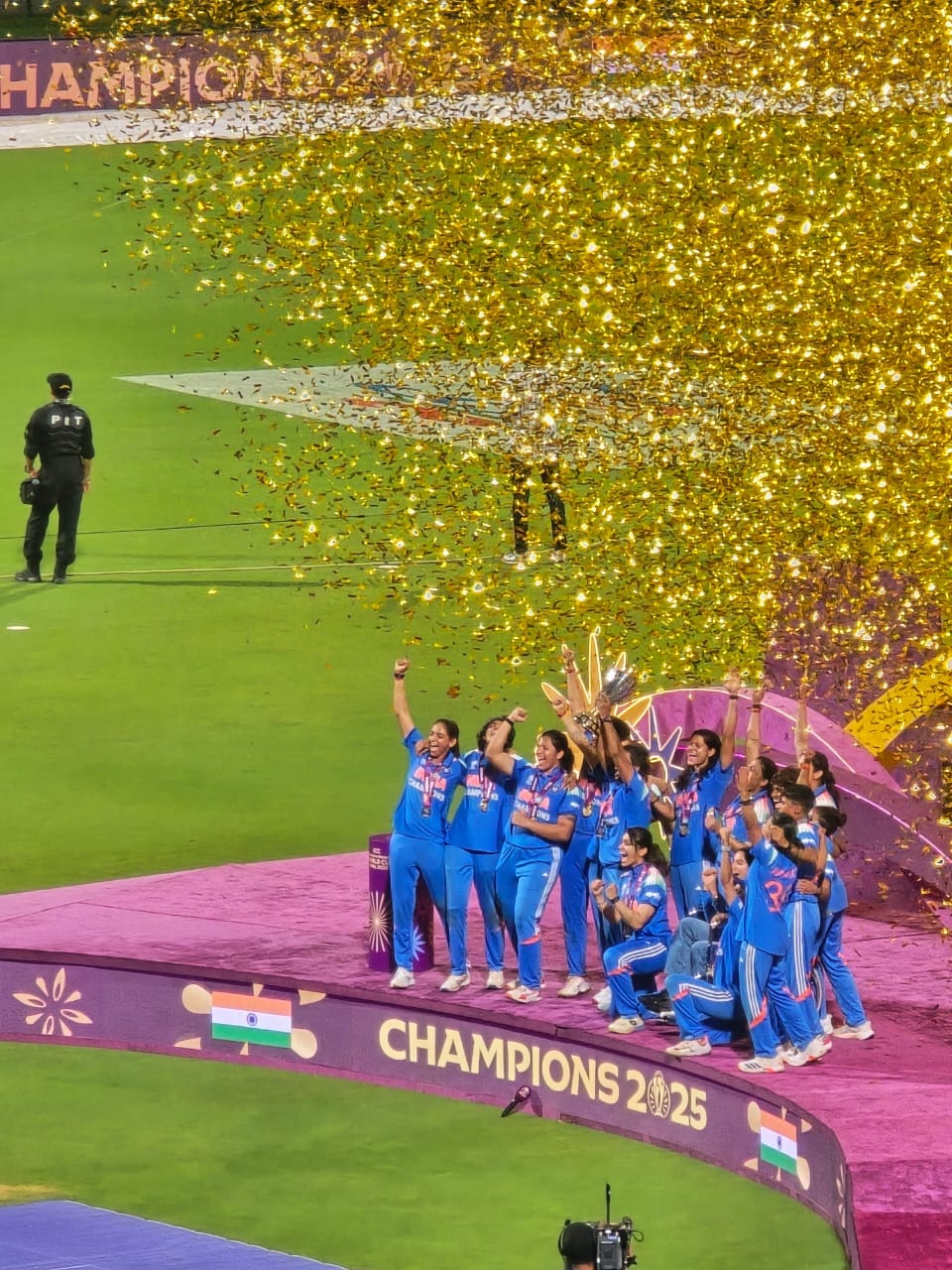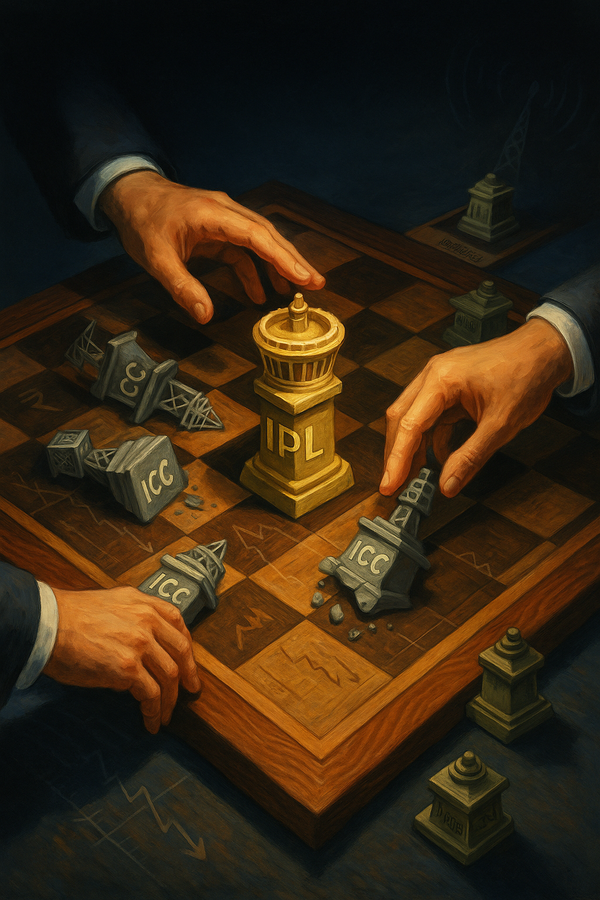The business behind India’s Women’s World Cup win
India’s World Cup win was the result of years of incremental reform, steady investment, and a league that treated women’s cricket as a business worth building.

You’ve likely seen the clip a dozen times, but it still holds.
The ball rose off South Africa’s Nadine de Klerk’s bat and drifted towards extra cover. Indian captain Harmanpreet Kaur moved a few paces left, eyes steady, body loose, every muscle tuned to instinct. She leapt and caught it cleanly. For a heartbeat, silence. Then came the noise, the rush that rolled around the DY Patil and made the night tremble.
From the commentary box, Ian Bishop’s voice carried through the din: “A victory that will ignite a nation! It will create a legacy for generations of young women to follow!”
A few minutes to midnight, Indian cricket met its tryst with destiny (hat-tip to Jatin Sapru).
India won its ICC Women's Cricket World Cup as global women's sport crossed a commercial threshold. Last year, the WNBA locked in $2.2 billion over twelve years. The National Women's Soccer League secured $240 million in broadcast deals.
India, with 1.4 billion people and a sports economy dominated by cricket, sat on the sidelines until the Women's Premier League (WPL) launched in 2023. This World Cup win validates what two years of data already showed: India is not only participating in women's sport, but also rewriting its rules.
The long build
Beneath the celebrations lay a system years in the making. The Board of Control for Cricket in India (BCCI) was not being visionary so much as diligent, putting resources where they should have been all along. But diligence, once delayed, can still be transformative.
The roots trace back to another final, one that ended differently. After falling nine runs short against England in 2017, the BCCI was jolted into action. It accelerated what had long been a reluctant process. Central contracts arrived in October 2015, giving 11 women professional status for the first time, a symbolic leap for a generation that once earned Rs 1,000 a match.
Between 2019 and 2022, the Women’s T20 Challenge travelled with the Indian Premier League, a modest multi-team experiment that tested appetite more than it promised spectacle. Broadcasters watched, sponsors waited, and the signs were good. If the product looked professional, India Inc would follow.
By 2023, the BCCI was finally ready for scale, after years of half-measures and hesitation. Five franchises sold for Rs 4,670 crore. Tata came in as the title sponsor for Rs 600 crore over five years. Adani bought the Gujarat Giants; the Royal Challengers Bengaluru and the Mumbai Indians joined with serious backing. Players’ base salaries ranged from Rs 10 lakh to Rs 3.4 crore, with marquee names such as Smriti Mandhana adding several more in endorsements. The BCCI had introduced pay parity a year earlier, in 2022: Rs 15 lakh for Tests, Rs 6 lakh for ODIs, and Rs 3 lakh for T20 internationals, matching the men’s rates.
“The BCCI really got behind the women’s game from 2019 onwards,” Shiv Burman, founder of Burman Sports, told The State of Play. “They built it patiently, with salaries and structure, and when it came to the WPL from day one, they wanted it to be sustainable. They didn’t bundle it with IPL and sold it separately. They are open to being creative with partners in the WPL. And have invested in marketing quite heavily with the broadcaster and influencers.”
That shift soon began to show in the numbers. Viacom18 paid Rs 951 crore for five-year broadcast rights. The league posted a first-year revenue of Rs 377 crore, with 50+ brands immediately buying into it on-air. Collective franchise valuations crossed several hundred million dollars within their first season, placing the WPL among the world’s most valuable women’s leagues.
About a hundred players now hold contracts; hundreds more work as coaches, physios, and commentators. For many who once travelled in borrowed kits, the WPL turned dream into a profession. The players who lifted the trophy on November 2 were products of this system.
“The talent has always been there,” Lisa Sthalekar, former Australia captain and International Cricket Council (ICC) Hall of Famer, told The State of Play, “but there was never a proper platform to showcase it. The WPL changed that. By putting players under pressure, under lights and in the media, it has unearthed a lot of talent. Kranti Gaud is the perfect example.”
Unlike the men's game, India did not win and then professionalise; the sequence ran the other way.
The centre of gravity
The NWSL’s 2024 championship drew 18.7 million viewers. The 2025 WNBA Finals averaged 1.4 million viewers. UEFA’s Women’s Champions League final peaked at 2.5 million across Europe. India’s WPL opener in 2025 alone saw more than 30 million, numbers that redrew the map.
By its third season, the league had reached 300 million viewers. Four of five watched online, according to a recent Capri Sports-KPMG report, revealing a young, digital-first audience that does not see women’s cricket as niche but as entertainment on par with the men’s game.
The WPL also changed the rhythm of the global game. Players from Australia, England, New Zealand, South Africa, and the West Indies now plan their seasons around India’s two-month window. As WPL salaries approach or exceed those of home leagues, India has become the gravitational centre of women’s cricket. That commercial gravity has also changed how women's cricket is perceived and sold.
Sthalekar noted that while men’s cricket feels commercially crowded, women’s sport still carries a sense of purpose: visibility, access, and equity. That, she said, makes it powerful for sponsors. “Men’s calendars are saturated. Women’s sport still has space to grow, and early investors will see returns that are both larger and longer-lasting.”
Those same ideas of “purpose” drew Unilever (via Rexona) and Google into the ICC sponsorship fold. The companies became standalone sponsors of women’s cricket in the 2025–26 cycle, occupying the two slots the ICC opened for the first time.
“It was an alignment of philosophy,” Anurag Dahiya, chief commercial officer, ICC, told The State of Play. “Brands see it as the right thing to do. Women’s sport is salient and more noticeable. There is less clutter and more authentic communication opportunities.”
That shift is visible in India, where brand endorsements tied to women’s athletes have grown more than 20% year on year. Sponsorship values are climbing, and top-tier players are set to command higher fees that rival mid-tier men’s cricketers.
The commercial transformation is real, but still in motion.
Beyond the trophy
True parity demands endurance, the kind that lasts beyond the victory lap. Deepti Sharma, the talismanic all-rounder and player of the tournament, had a straightforward plea for the BCCI: more matches and a fixed calendar that could help realise pay parity beyond match fees.
For the BCCI itself, this marks a rare inflection point. For decades, Indian cricket’s administration expanded in scale but not necessarily in design. The women’s game, built almost from scratch, offers a chance to rethink how the sport is governed, more commercially aware, better coordinated, more accountable, and definitely more inclusive. It has also forced the board to confront the question of who gets to run the game.
Few women occupy meaningful roles in its committees or state associations, and attitudes within cricket’s bureaucracy often lag behind developments on the field. Building a deeper pipeline of women administrators and holding state units to higher standards on governance and infrastructure will decide whether this moment becomes a reset or a one-off.
The domestic season remains the starkest gap. It operates in fragments, squeezed between men’s tournaments and international fixtures. The BCCI increased its budget for women's domestic cricket to Rs 96 crore for 2025-26, but scheduling conflicts persist. The men play year-round; the women wait for windows.
“Cricket in India still lives mostly in boys’ schools,” Sthalekar said. “If young girls get the same opportunities early on, the game will grow even faster. This victory shattered many stereotypes, not just in big cities but also in smaller towns. It made it OK [for a woman] to be a cricketer.”
The men’s game has gained from fifteen years of accumulated infrastructure and institutional memory. The women’s game is assembling those basics. Yet starting late carries one advantage: the freedom to do things differently.
The WPL already hints at that freedom. Players speak mid-game, cameras catch on-field conversation, stories lead the coverage, and the broadcast windows are short and sharp. It feels contemporary, and it works.
The next over
The WPL mega-auction takes place later this month, and the spending on World Cup heroes will be an early signal of where the market is heading.
Corporate India faces its own test. Brands must decide if the World Cup opened a genuine market or just created a moment to exploit. The Women’s T20 World Cup arrives in mid-2026; what happens between now and then will show whether this is business or bandwagon.
Globally, India represents both opportunity and challenge: opportunity because it proves that massive audiences exist beyond traditional markets, challenge because India’s advantages make it hard for others to keep up. The gap between India and the rest could widen, forcing boards and leagues elsewhere to match investment or risk diminishing relevance.
When the lights dimmed at the DY Patil, the cheers softened into something steadier: belief. Harmanpreet Kaur’s girls had broken the barrier, but as she reminded them, excellence must now become a habit.
The Position
The deals, moves and numbers shaping sport
🔍 Review: United Spirits has initiated a strategic review of its investment in Royal Challengers Sports Private Limited, which owns the men’s and women’s Royal Challengers Bengaluru teams. The process, typically seen as a prelude to an eventual sale, is expected to be concluded before March 31, 2026. (Also read: Decoding the RCB sale hypothesis 🔒)
🔄 Rebrand: The Hundred franchise Northern Superchargers will be renamed Sunrisers Leeds from next season. Chennai-based Sun Group, which paid £100 million for the team, has filed documents with the UK’s Companies House to formalise the change.
📺 Now TikTok-ing: This Saturday’s National League clash between Carlisle United and Southend United will be the first to stream live on TikTok. DAZN, which secured the rights to the fifth tier of English football last year, will broadcast the match on its TikTok channel.
💬 Cosy: It’s not the Nobel, but US President Donald Trump could be walking away with a Peace prize after all. FIFA president Gianni Infantino, while announcing the “FIFA Peace Prize”, hailed Trump, calling him his “really close friend.”
The Stack
Worth your time
↩️ The science of swing bowling: Do overhead conditions really make a difference? (The Athletic)
🕹️ Why Football Manager just keeps winning (Financial Times)
🔢 The BookKeeper: Exploring the dizzying world of Barcelona’s finances, levers, and debts (The Athletic)
That’s all for today.
If you’ve got thoughts, tips (the info kind, not the money kind), or things you think I should be paying attention to — reply here or reach me at venkat@stateofplay.club.
See you next week.





